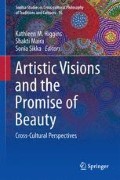Abstract
This chapter focuses on the classical Daoist text, the Zhuangzi, an extremely important text for sources and influences on Chinese art and aesthetics. It explores several metaphors and images in the text in order to think through Daoist aesthetics in terms of the everyday, the mundane, and the ordinary, and in terms of the fantastical, the bizarre, and the extraordinary. It then discusses these aesthetic ideas in connection with Daoist practices of self-cultivation, including especially a focus on the use of art practices such as calligraphy as forms of cultivation. This theme is developed further by thinking through ways in which Daoist aesthetics evoke the idea of an artful life, rather than art qua art.
Access this chapter
Tax calculation will be finalised at checkout
Purchases are for personal use only
Notes
- 1.
For more on Chinese aesthetics and self-cultivation in terms of philosophy, see Mattice, 2013.
- 2.
Dao 道 is simulaneously one of the most important and one of the most difficult terms to deal with in Chinese philosophy. Broadly speaking, it carries (at least) three general meanings: (1) way(s), road(s), path(s); (2) The activity of making or building way(s), road(s), or path(s); and (3) Prescriptive discourse, as in the “way” to do something, how something is or should be done. In much Daoist discourse, dao often refers to something like the totality of worldy and cosmic phenomena.
- 3.
For more on these figures, including images and recordings, see: http://www.chinaonlinemuseum.com/calligraphy-wang-xizhi.php; http://plato.stanford.edu/entries/neo-daoism/supplement.html; http://www.silkqin.com/02qnpu/32zczz/jiukuang.htm; http://www.metmuseum.org/toah/works-of-art/47.18.10
- 4.
Wheelwright Bian is a character in the Zhuangzi, see later in the essay for the passage in detail.
- 5.
- 6.
There are no available reproductions or images of this painting, but images of similar paintings are available in Zhou 2005. See also Sam Crane on connections between Zhuangzi and Ai Weiwei:
http://uselesstree.typepad.com/useless_tree/2014/01/ai-weiwei-zhuangzi-and-life-at-the-margins.html
- 7.
While there has been some scholarly debate about how to understand the terms daojia and daojiao, which were first used by Wang Bi, nineteenth and twentieth century attempts to map these onto philosophy (daojia 道家, “Daoist Lineage”) and religion (daojiao 道教, “Daoist Teachings”) have largely been shown to be ill-informed. Although this essay focuses on philosophy, the classical texts and the lived practices of different Daoist traditions should be understood as intimately connected.
- 8.
Unless otherwise noted, all translations from the Zhuangzi are my own, with reference to Graham, 1989. Chapter location is given after each quotation.
- 9.
For more on the Zhuangzi in terms of play, see Mattice, 2014.
- 10.
In Classical China, disfigurement was often a form of punishment, and this kind of disfigurement is seen in the Zhuangzi, along with disfigurements from birth, age, and other causes.
References
Ames, Roger T. 1998. Introduction. In Wandering at ease in the Zhuangzi, ed. Roger T. Ames. New York: SUNY Press.
Bush, Susan, and Hsio-yen Shih. 1985. Early Chinese texts on painting. Cambridge: Harvard University Press.
Chang, Cheng-yuan. 2011. Creativity and Taoism: A study of Chinese philosophy, art and poetry. London: Singing Dragon Press.
Egan, Ronald. 1994. Word and deed in the life of Su Shi. Boston: Harvard University Center.
Gier, Nicholas. 2001. The dancing Ru: A Confucian aesthetics of virtue. Philosophy East and West 51(2): 280–305.
Graham, A.C. 1989. Chuang-tzu: The inner chapters. Indianapolis: Hackett Publishing.
Jullien, Francois. 2007. The Impossible Nude. Trans. Maev de la Guardia. Chicago: University of Chicago Press.
Jung, Soomin. 2013. Artist Statement. http://contemporaryartmonth.com/exhibit/2013/other-side
Komjathy, Louis. 2013. The Daoist tradition: An introduction. New York: Bloomsbury.
Lee, Tosi. 2004. Fire down below and watering, that’s life: A Buddhist reader’s response to Marcel Duchamp. In Buddha mind in contemporary art, ed. Jacqueline Bass and Mary Jane Jacob. California: University of California Press.
LI Zehou and LIU Gangji. 1984. Zhongguo Meixueshi (History of Chinese Aesthetics). Beijing: Xinhua.
Li, Zehou. 2009. The Chinese Aesthetic Tradition. Trans. Majia Bell Samei. Honolulu: University of Hawaii Press.
Mattice, Sarah. 2013. Artistry as methodology: Aesthetic experience and Chinese philosophy. Philosophy Compass 8(3): 199–209.
Mattice, Sarah. 2014. Metaphor and Metaphilosophy: Philosophy as combat, play, and aesthetic experience. Maryland: Lexington Books.
McCraw, David. 2010. Stratifying Zhuangzi: Rhyme and other quantitative evidence. Taipei: Institute of Linguistics, Academica Sinica.
Ni, Peimin. 2002. Moral and philosophical implications of Chinese calligraphy. In Wandering: Brush and pen in philosophical reflection. Chicago: Art Media Resources Limited.
Pohl, Karl-Heinz. 2006. Chinese aesthetics and Kant. In The pursuit of comparative aesthetics, ed. Mazhar Hussain and Robert Wikinson, 127–136. Vermont: Ashgate Publishing.
Qiu, Peipei. 2005. Interview with Robert D. Wilson. In Simply Haiku, 3/4. http://simplyhaiku.com/SHv3n4/features/Peipei-Qiu_interview.html
Wang, Youru. 2004. The strategies of Goblet words: Indirect communication in the Zhuangzi. Journal of Chinese Philosophy 31(2): 195–218.
Wenning, Mario. 2014. Crossing boundaries: Zhuangzi and Bashō on the art of travel. In Landscape and travelling East and West: A philosophical journey, ed. Hans-Georg Moeller and Andrew K. Whitehead, 9–22. London: Bloomsbury Academic Press.
Zhou, Yan. 2005. Odyssey of culture: Wenda Gu and his art. New York: Springer.
Author information
Authors and Affiliations
Corresponding author
Editor information
Editors and Affiliations
Rights and permissions
Copyright information
© 2017 Springer International Publishing Switzerland
About this chapter
Cite this chapter
Mattice, S. (2017). Daoist Aesthetics of the Everyday and the Fantastical. In: Higgins, K., Maira, S., Sikka, S. (eds) Artistic Visions and the Promise of Beauty. Sophia Studies in Cross-cultural Philosophy of Traditions and Cultures, vol 16. Springer, Cham. https://doi.org/10.1007/978-3-319-43893-1_19
Download citation
DOI: https://doi.org/10.1007/978-3-319-43893-1_19
Published:
Publisher Name: Springer, Cham
Print ISBN: 978-3-319-43891-7
Online ISBN: 978-3-319-43893-1
eBook Packages: Religion and PhilosophyPhilosophy and Religion (R0)

